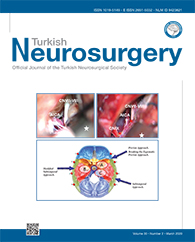MATERIAL and METHODS: Forty-seven pediatric patients with hydrocephalus who underwent successful ETV in our clinic between 2011 and 2015 were included in this study. Preoperative and postoperative three-month CA, lateral ventricle frontal horn (LVFH) width, Evansâ index (EI), and frontal-occipital horn ratio (FOR) parameters were recorded, with changes analyzed using a paired-samples t-test.
RESULTS: There were 29 male and 18 female patients included within the cohort. For mean preoperative values, LVFH width was 58.8 ± 14.9 mm, EI was 0.43 ± 0.09, FOR was 0.51 ± 0.74, and CA was 78.5° ± 36.4°. Separately, for mean postoperative values, LVFH width was 54 ± 14.2 mm, EI was 0.39 ± 0.09, FOR was 0.47 ± 0.07, and CA was 104.5° ± 32.6°. The CA was increased and the LVFH width, EI, and FOR were decreased in all patients within three months after surgery. The postoperative three-month change in CA was higher than those observed in the other parameters.
CONCLUSION: Changes in CA after successful ETV were dramatically higher than those in the other ventricular parameters. For this reason, we suggest CA be used as a radiological criterion during early radiological follow-up of patients after ETV.
Keywords : Pediatric hydrocephalus, Callosal angle, Endoscopic third ventriculostomy




